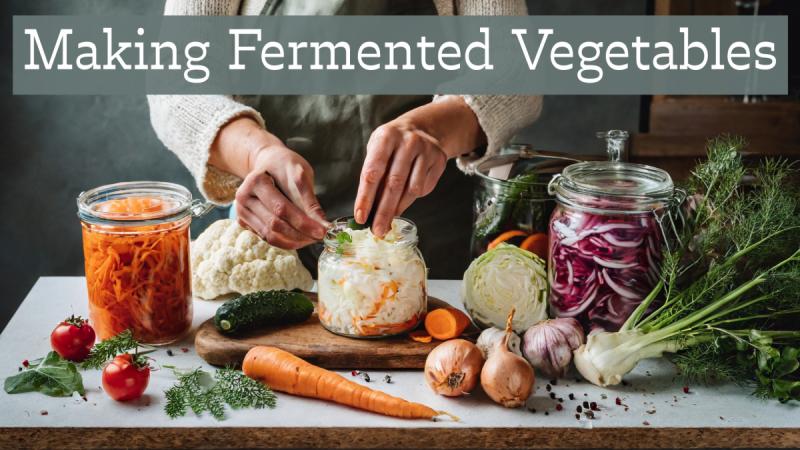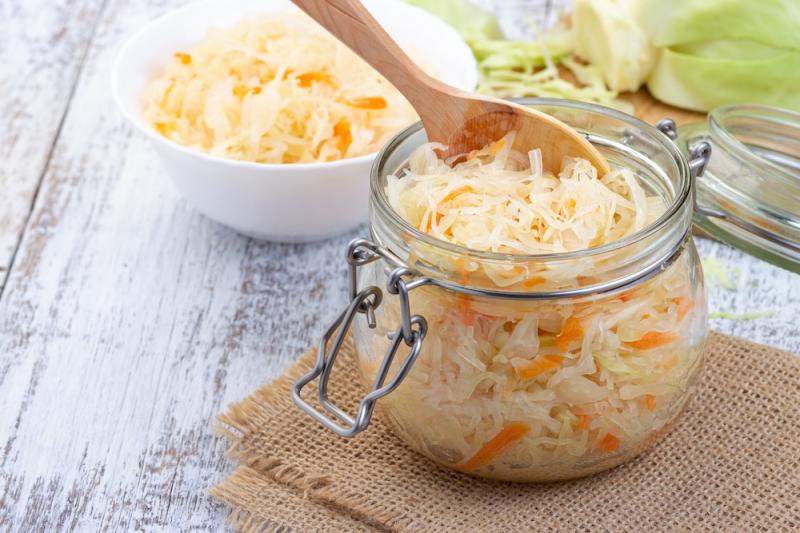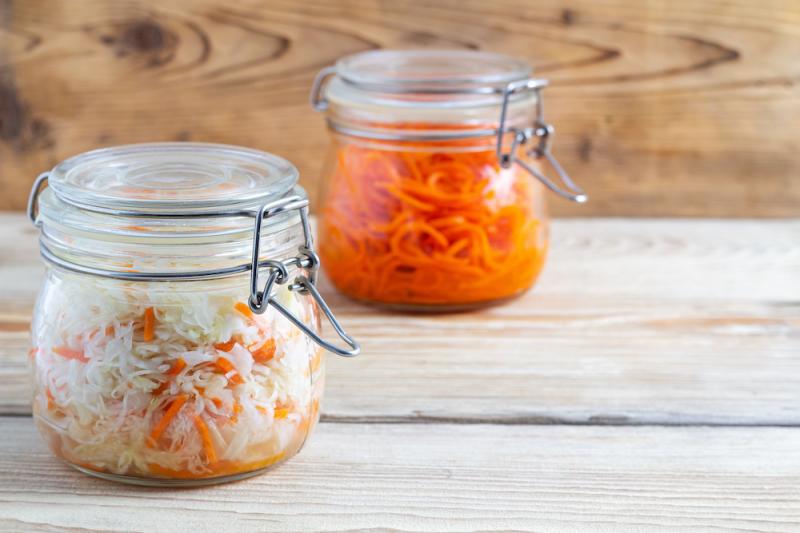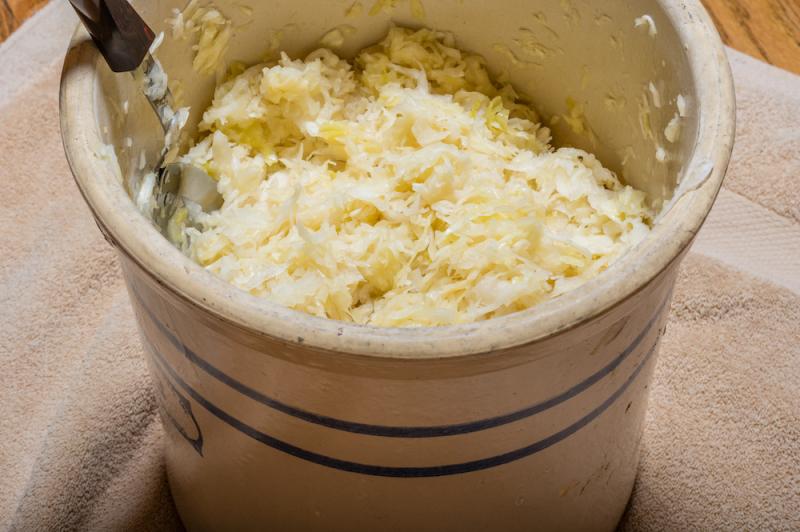
Probiotics (friendly bacteria) are an important part of intestinal health, which is why many people try to use probiotic supplements and fermented foods to restore gut health. Yogurt and other fermented dairy products like Kiefer are often promoted as foods for improving gut health, but fermented vegetables are probably the best ways to repopulate the colon with friendly bacteria. You can purchase fermented vegetables at many health food stores and even some supermarkets, but they are also very easy to make.
You can make them with equipment as simple as a one-quart mason jar or you can get fancy and buy some larger jars with lids that have fermentation locks. Traditionally, people used large ceramic crocks. You can also buy special weights to hold the vegetables down, but that isn’t absolutely necessary.
Basic Ingredients
 Here is the basic recipe.
Here is the basic recipe.
- 4 cups finely chopped vegetables
- 1 Tablespoon salt
- 1 Tablespoon seasonings (optional)
- You can also add a probiotic culture starter (available at many health food stores), powdered probiotic supplements or empty the contents of 2-4 capsules of a good probiotic supplement.
This is not essential, but it helps, and you may be able to use less salt if you use a probiotic powder. You can also use a couple of tablespoons of whey as your starter. Whey is the liquid that you get when yogurt separates. If you’re using the culture starter or probiotic supplement mix it with a little lukewarm water to start activating the bacteria.
Directions
 In a large bowel mix the vegetables, salt, and seasonings.
In a large bowel mix the vegetables, salt, and seasonings.
Use a meat pounder to smash the vegetables a little to release some of their juices. You could also use some other tool such as a heavy potato masher. This step is optional but it helps the fermentation process.
Pack the vegetables into a quart glass mason jar or fermentation vessel and tap the vegetables down.
If you are using a probiotic culture starter or other probiotic starter add it in now.
Add additional water until the vegetables are completely covered in liquid. To keep them submerged you need some kind of weight. A pickle crock comes with a weight. You can also buy weights that fit in mason jars. In my pickling jars, I’ve simply filled a zip-lock bag with water, tightly sealing it so it wouldn’t leak, and used that as a weight.
If you’re using a regular mason jar and don’t use a fermentation lock put the lid on loosely. Do not screw it on tight. The fermentation process creates gases and you need to allow them to escape.
Set the jar or other container aside and keep it at room temperature for at least three days. You should observe some bubbles forming in the jar when it starts to ferment. Taste it after three days. It should be slightly tart. If not, leave it at room temperature for another day or two. Then refrigerate and enjoy.
Specific Recipes
 Here are some specific recipes I like. My favorite is the Cauliflower and Cabbage with Curry Powder, but I also like the Ginger Carrots.
Here are some specific recipes I like. My favorite is the Cauliflower and Cabbage with Curry Powder, but I also like the Ginger Carrots.
Basic Sauerkraut
- 4 cups finely chopped raw cabbage
- 1 Tablespoon salt
- 1 Tablespoon caraway seeds (optional)
Cauliflower and Cabbage with Curry Powder
- 2 cups of raw cauliflower cut into small pieces
- 2 cups of finely chopped raw cabbage
- 1 Tablespoon salt
- 1 Tablespoon curry powder
Beet and Cabbage Blend
- 2 cups grated raw beets
- 2 cups finely chopped raw cabbage
- 1 Tablespoon salt
- 1 Tablespoon dill weed
Ginger Carrots
- 4 cups grated raw carrots
- 1 Tablespoon salt
- 1 Tablespoon grated fresh ginger
There are many other variations using different vegetables and spices. For example, using cucumbers to make fresh fermented pickles. Whatever you try for the best probiotic benefit remember to eat your fermentations raw.
Steven's Articles
-

-
The Evidence for Berberine
A yellow alkaloid found in traditional infection-fighting…
-

-
The Sensible Use of Caffeinated Herbs
Kola nuts, guarana, and yerba mate and other herbs…
-

-
The Health Benefits and Problems with Coffee
This popular caffeinated beverage can be beneficial…
October
-

-
Understanding Caffeine & Cellular Adaptation
Preserving the power of caffeine's buzz and the…
September
-

-
Horseradish
A pungent spice for aiding protein metabolism…
-

-
Banaba or Crepe Myrtle
A beautiful tree from Southeast Asia whose leaves…
August
-

-
Monkeyflowers
Flower essences to help see ourselves more clearly…
-

-
Mariposa Lilies
Strengthening the bond between mother and child…
-

-
The Noble Bay Leaf
A common kitchen herb for aiding digestion and…
-

-
Epimedium: Horny Goat Weed
A circulatory stimulant and kidney yang tonic…
July
-

-
The Medicinal and Nutritional Benefits of Apricots
A nutritious fruit and valuable medicinal seed for coughs
-

-
Dogwoods
Asian dogwood is used to stop excessive discharge,…
June
-

-
Neem: The Village Pharmacy
A popular Ayurvedic remedy for dental and immune…
-

-
Spilanthes: The Toothache Plant
A traditional remedy for teeth and gums, as well…
-

-
Forsythia
An anti-inflammatory, fever-reducing, and infection fighting herb

